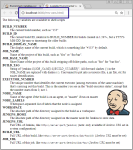我就纳闷了,铺天盖地的各种jenkins实操,咋就没有面向白白授人以鱼,快速上手的简单指导呢?自己整理如下:
slave概念:slave需要添加,它是用来干嘛的?它或它们可能是一台服务器,采用jenkins母机对其们进行构建和部署及配置
blue ocean:插件之一,需要jenkins2.7.x以上版本。
同类软件:hudson,bamboo。teamcity。travisci。
非常有用,划重点:☆☆jenkinsfile,pipeline的语法参考,一堆的steps的语法https://jenkins.io/doc/pipeline/steps/
jenkinsfile的sample https://github.com/jfrog/project-examples
jenkins的一些模块的参数:https://jenkinsci.github.io/job-dsl-plugin/#method/javaposse.jobdsl.dsl.helpers.publisher.PublisherContext.publishCloneWorkspace
jenkins的pipeline支持的插件https://github.com/jenkinsci/pipeline-plugin/blob/master/COMPATIBILITY.md
jenkins pipeline 的 语法https://jenkins.io/doc/pipeline/steps/
cloudbees学习网站,一站式学习,非常经典
https://premium.cbu.cloudbees.com/cloudbees-university-jenkins-pipeline-fundamentals
https://premium.cbu.cloudbees.com/cloudbees-university-jenkins-fundamentals
https://jenkins.io/doc/pipeline/examples/
jenkinsfile语法:https://jenkins.io/doc/book/pipeline/syntax
jenkins命令:https://jenkins.io/doc/book/pipeline/syntax/
jenkins的那些命令哪儿来的?在这里:https://jenkins.io/doc/pipeline/steps/
jenkins的console script的参考:https://github.com/jenkinsci/jenkins-scripts/tree/master/scriptler 划重点:非常重要的资源地址,可以查到 https://wiki.jenkins.io/display/JENKINS/Jenkins+Script+Console#JenkinsScriptConsole-ExampleGroovyscripts https://javadoc.jenkins-ci.org/hudson/model/package-tree.html
https://javadoc.jenkins-ci.org/hudson/model/package-tree.html
https://github.com/jenkinsci/jenkins-scripts/tree/master/scriptler
jenkins主要案例:
1.基于ECS执行,ECS的绑定方式:安装插件,在manage jenkins内增加ECS,根据aws上的资源号进行设置,需要ECS的credential
pipline特点:
1.master可以重启,pipeline不受影响
2.可暂停
两种:
declarative pipeline:
较新
agent指定slave(declarative采用node指定slave)
严格的语法结构,对groovy要求不高
blueocean生成流水线
script pipeline
1.比较豪放,对groovy要求略高
采用node指定slave
3.Scripted Pipeline code must explicitly handle the checkout scm step,脚本流水线必须显示的执行checkout scm步骤
语言,Uses a DSL based on Apache Groovy ,"DSL" (Domain Scripting Language)
blueocean用法:在jenkins传统界面的左侧有一个打开blueocean(这个是插件安装上去的),打开后进入到blueocean的界面,里面可以点击添加流水线,可以选种类
jenkins规则:
1.slave/agent,一般非特殊情况,命令在这其上执行
2.jenkins构建的包会保留在工作空间内,除主动删除外永久保留
3.parallel:Each "parallelized branch" is a stage A stage can use either steps or parallel at the top level; it cannot use both A stage within a parallel stage can contain agent and steps sections A parallel stage cannot contain agent or tools Add failfast true to force all parallel process to abort if one fails
pipeline和multibranchpipeline
1.优选multibranchpipeline,why???
2.blueocean创建的pipeline全部都是multibranch的
3.multibranch可以为新分支直接创建流程
4.当git的分支被删除时,对应的role也会被删除
5.可以覆盖父任务的设置,即个性定制
agent:
1.agent any,可以在任意一个agent上执行;
2.agent none,写在全局的位置,表示每个stage可以定义自己的agent
3.当在step里时,当有需要在agent上执行的命令时不能使用agent none,废话……
4.agent {label 'xxxx'},很重要,指定用哪个agent
5.agent指定docker镜像或者dockerfile,只能用于multibranch pipline: pipeline { agent { docker 'bzzzcentos:7' } .... }
pipeline { agent none stages { stage ('Build') { agent { label 'bzzzmaven' } steps { ... } } stage ('Deploy') { agent { label 'bzzzproduction' } steps { ... } } } }
6.script方式的:node('xxx'){container('ccccc'){checkout scm stage 'vvvv'{}}}
技巧:
1.可以使用blueocean界面编辑方式生成一个大概的脚本,细节的再具体调试
1.jenkins代码生成应用,就在jenkins内,当创建流水线的时候里面有个链接叫pipeline-syntax:https://dso.ci.kingland.cc/job/ami-update/pipeline-syntax/
2.创建pipeline的时候有definition选项,有俩,一个叫pipeline script from SCM表示从git库拉取jenkinsfile,一个叫pipeline scrip,选择这个后就可以在下面弹出代码框进行编辑(保存后或者执行后是否会在git库中同时生成一个jenkinsfile?)
3.优选multibranch pipline的方式
4.multipipeline的设置,第一级项目设置的进入方法:项目总览页,项目名称旁边有个齿轮设置按钮,进入后左侧有个config。
5.agent(node)可以定义在全局,也可以定义在每个stage内
jenlkins 中k8s配置:在管理界面的系统配置里,添加云服务,俩选项,一个是java一个是k8s,选择k8s后一路向下可以看见有一个pod template选项,点开后即可看见一个标准的pod的镜像参数。即可
agent或者node的设置:https://jenkins.io/doc/book/pipeline/docker/
区别是声明式的是单独的agent{}用在stage下,并且和step{}同级,脚本式的是在stage里的docker.image('').inside{xxxxxx}
宣明式jenkinsfile常用命令:
1.environment: 配置变量,用于stage内或者全局
2.option:
3.parameters: 在全局声明parameters,在stage内引用时使用${params.xx}调用
4.triggers:
脚本式jenkinsfile常用命令:
1.if else
2.try catch finally
jenkins script console 在jenkins server或者node上执行简单的命令,比如查看磁盘空间,巴拉巴拉巴拉之类的咋办?
https://blog.youkuaiyun.com/xiaosongluo/article/details/54564069参考这个链接,然后总结如下:采用groovy的语法执行要干的事儿,比如可以直接println(xxxxxxx),再比如想解密jenkins里的credential的密码,就可以仍在这里面用println打出来,解析的方法是hudson.util.secret.decrypt
println(hudson.util.Secret.decrypt("{xxxxx=}"))
jenkins 的 credential:
1.一些必备的登录验证可以捆绑于此,然后在jenkins内使用withcredential调用。里面有个参数叫credentialids既是这个。
jenkins的几种任务:
1.直接配置的;
2.单独配置pipeline的
3.配置multipipeline的
实战1.jenkins +aws + ECS:创建master和slave
实战2:部署案例:AWS+ ECS + docker部署一个服务:https://aws.amazon.com/getting-started/tutorials/deploy-docker-containers/
关于trigger:https://wiki.jenkins.io/display/JENKINS/Building+a+software+project
实战3,构建案例:jenkins,创建一个freesytle,重点:poll SCM的设置,buildenv的选择是gradle-artifactory(有一个deploy server和一个resolve server,干啥的呢?deploy是传文件的,resolve是从哪里拉依赖之类的),选取这个gradle-artifactory后就会在下方显示artifactory相关的选项(jenkins的一个技巧:jenkins可以安插件,插件会在job的设置里出现,job中可以延伸很多模块)
实战4,在console里通过groovy脚本获取job信息及执行命令https://github.com/jenkinsci/jenkins-scripts
实战5,关于credential,https://jenkins.io/doc/developer/security/secrets/
实战6,jenkins内执行命令操作jenkins master,在script里执行下述代码
def sout = new StringBuilder(), serr = new StringBuilder()
def proc = 'ls /tmp'.execute()
proc.consumeProcessOutput(sout, serr)
proc.waitForOrKill(1000)
println "out> $sout err> $serr"
实战7,disable 和enable:在freestyle中的configure中可以设置,一旦disable,project不会再被执行,除非设置为enable状态,作用是当知道这个project一段时间内不需要执行时设置成disabled
>>>>>>>>>>>>>>>>>>>>>>>>>>>
slave选择,在configure中可以选择是否限定slave,其中可以选择master,也可以选择某个label,也可以或,用||,比如master||xxx
>>>>>>>>>>>>>>>>>>>>>>>>>>>
关于jenkins的语法,查询了一些文章,真TMD的垃圾,就不能用人类的语言好好记录?直接机器翻译jenkins docs……,而且没有系统的整理的文章。中国的各行业实打实的技术知识储备,可见一斑:短,懒,虚
jenkinsfile的语法及变量等信息可在jenkins内查看到,路径是jenkins的地址/pipeline-syntax/globals#env,可以看到全局变量
回答几个问题:
1.properties是干啥的?
2.当点击构建时的可选或者手填参数,是在哪里设置的?multibranch中的branch单独手动添加这个值还是在jenkinsfile中生成的?
3.jenkinsfile内的全局变量,带类型声明和不带类型声明的区别?带类型是强制
4.局部变量的作用域?
5.check scm:
6.artifactory怎么设置?在哪里设置?请见devops架构篇
7.stage内withenv和def的区别?withenv只用于当前stge,而直接声明的变量可以用于全局
8.一些jenkinsfile里常用的step:Pipeline Utility Steps,比如readproperties https://jenkins.io/doc/pipeline/steps/pipeline-utility-steps/和https://jenkins.io/doc/pipeline/steps/
9.docker的相关命令:比如withrepository,见jenkins的地址/pipeline-syntax/globals#env,同全局变量在一起
10.parallel命令: 并行执行,比如在pipeline中有测试步骤,没有必要按序执行,此时可采用parallel加于执行的步骤之前表示这个步骤执行中继续进行后续的步骤https://jenkins.io/doc/book/pipeline/jenkinsfile/#parallel-execution
11.build命令:调用另一个job,直接使用build https://jenkins.io/doc/pipeline/steps/pipeline-build-step/
12.基本模块:比如dir之类的https://jenkins.io/doc/pipeline/steps/workflow-basic-steps/
一,变量:
来源:
1.env.xx:jenkins系统变量,在构建过程中可传递至job内,比如构建的版本,变量名是固定不变的,在jenkins主地址/https://dso.ci.kingland.cc/pipeline-syntax/globals下可以找到,等同于ansible中的系统变量的使用方式。貌似可以直接调用已定义的系统变量,比如直接引用BRANCH_NAME而不加env
2.properties():
3.string xx = :用string的意思是:
4.boolean类型: boolean xxx = a = b,第二个等号先执行,返回结果通过第一个等号传值true或false给xxx。
jenkins哪里设置自定义的全局变量?
当变量是list时,声明使用def xxx = [ key : value,key:value]各个值之间可以换行,但是得有逗号。调用时
调用:
${xxx}
语法:调用时如果最外层是单引号,内部的${}不会解析为变量。原装不动的解析为${}.双引号不会,即单引号表示省略转义
二,credential传值
1.credential传值可以通过withcredential这个方法,具体见参考链接https://jenkins.io/doc/pipeline/steps/credentials-binding/
简单套路:withcredential(可以通过变量传进来,一个列表){在这个credential下要干的事儿}
三,方法定义,固定方法引用
四,动态变量传值,在multibranch类型的pipeline里,在每个branch内名称右侧或者左侧菜单栏有一个view configure可以添加动态参数
五,artifactory的调用语法:https://www.jfrog.com/confluence/display/RTF/Working+With+Pipeline+Jobs+in+Jenkins
六.流水线中动态传参,即在执行的时候可以临时传入参数,有两种情况:
1.普通pipeline:创建job时在build里有一个选项叫parameter,在其下可以添加不同类型的参数。在jenkinsfile内就可以使用param.xxx引用
2.multibranch:因为是基于jenkinsfile的一个父job,只有在进入分支后再点击configure才相当于普通piepline的config,里面有预设参数。但是这样就比较麻烦,要逐个分支进行配置
七,Scan Multibranch Pipeline Now的scan的作用:当点击的时候会发生什么事?
八,withcredential:([[],[],()……])可以同时传递多个credential,比如class类型的,file类型的等等https://jenkins.io/doc/pipeline/steps/credentials-binding/
九。jenkins传参:def,env,properties的区别(properties定义的变量,会在点击执行时生成动态传参对话框,有几种类型)
1.env.获取的变量时jenkins的环境变量,随处可以获取
2.设置环境变量:声明式的使用environment,脚本式的使用withenv(),在哪里声明,适用于哪里,比如在stages内声明,那就只能在stages内生效
3.内置变量,比如上一步buil结束后保存的版本号,在execute shell内可以查看到内置了哪些变量(点击下方链接),引用方法:在execute shell内使用%xx%引用,在jenkinsfile内使用env.xxx引用
4.def指定的就是一个可变的变量,可改值
5.赋值变量:env.xxx = xxxxxx
一.agent篇:当有实体机时,在manage jenkins里的sysconfig里配置agent,agent可以选择安装基础镜像
二.
1.执行命令:sh或者bat(windows)declarative里sh咋整? 直接sh ‘xxxx’,如果是多行?'''xxx ccc dddd'''即可,两种流水线都是这样的,windows用bat
2.declarative和script的区别: script很随意,直接node下stage。
3.retry 和 timeout模块,针对一个step重试或者超时,还可以嵌套组合
4.结束后的处理;decla采用的是用post命令,script用try catch和finnally,语法非常像java
jenkins权威指南 https://www.bogotobogo.com/DevOps/Jenkins/images/Intro_install/jenkins-the-definitive-guide.pdf
>>>>>>>>>>>>>>>>>>>>>>>>>>>>>>>>>>>>>>>>>>>>>>>>>>>>>>>>>>>>>>>>>>>>>>>>>>
jenkins 与 artifactory集成:参考下面的两个链接即可:
https://www.jfrog.com/confluence/display/RTF/Working+With+Pipeline+Jobs+in+Jenkins
其中有个鸡肋的功能 ,叫artifactory staging,会在job的左侧工具栏生成一个叫这个东东的东西(首先在config里选中那个enable release management)。这个功能在freestyle里可以直接配置,但是在pipeline里没法用。调研了一大堆的东西都不行:
链接里给了一个思路:以maven为例的:首先那个功能核心要干的事儿就是版本迭代的管理(修改pom或者gradle.propoties文件,然后推到repository库内),文档给的办法是先修改pom或者那个propoties文件,然后使用这个Allowing Interactive Promotion for Published Builds 功能promote到artifactory上去。实际上在artifactory上是保留了每次的build的包的,只是状态不同,有的是rollback,有的是promote,有的是其他的。只需要修改即可。
jenkins还是有很大的改进空间的。太不友好了,包括很多功能和参数,都简洁到令人发指,你tmd不说参数叫啥名,choice有哪些可选项,我怎么知道那些个鬼?读源码??????????????额滴神。
artifactory在jenkins上的release management管理,当选中时会生成两个功能,一个在左侧工具栏上,一个在build之后的number的后面。后面那个小按钮可以通过“”“Allowing Interactive Promotion for Published Builds” 这个生成,在pipeline里配上即可。具体方法见上面的链接
>>>>>>>>>>>>>>>>>>>>>>>>>>>>>>>>>>>>>>>>>>>>>>>>>>>>>>>>>>>>>>>>>>>>>>>>>>>>>
jenkins中的括号 中括号 https://github.com/jenkinsci/pipeline-plugin/blob/master/TUTORIAL.md
git url: 'https://github.com/jglick/simple-maven-project-with-tests.git', branch: 'master'As before, Groovy lets you omit parentheses around function arguments. The named-parameter syntax is also a shorthand for creating a map, which in Groovy uses the syntax [key1: value1, key2: value2], so you could also write:
git([url: 'https://github.com/jglick/simple-maven-project-with-tests.git', branch: 'master'])jenkins 使用tool 。首先在manage jenkins里面有个globle tool config,在里面配置tool,比如起个名叫xxx,下拉选取要安装的工具的版本,比如jdk的9.然后确认。在pipeline内就可以通过下面的语法调用:
env.JAVA_HOME="${tool 'jdk-8u45'}"
env.PATH="${env.JAVA_HOME}/bin:${env.PATH}"
jenkins 报错
fatal: git fetch-pack: expected shallow list 在jenkins的配置文件里不选 shallow clone即可,原理??还没看
》》》》》》》》》》》》》》》》》》》》》》》》》》》》》》》》
本地搭建一台jenkins server
步骤:
》》》》》》》》》》》》》》》
jenkins 内置变量:

jenkins引用groovy共通方法:https://www.jianshu.com/p/35b4fe64cebf。。目的是把一些共通
功能抽提出来,然后放到一个公共库内。使用的时候通过配置后直接调用,类似于java的lib包,jenkinsfile里的引用方式是@Library
jenkinsfile内引进tool: 首先在manage jenkins里的globle xx里找到gradle,点击就可以选择版本。选中后保存。在jenkinsfile中使用如下脚本:
tools{
gradle: "the name defined in the globle"
}
stages{
stage(test){
gradle clean .....
}
}
jenkins 在config中设置了环境变量,同时在checkout中引用,但是未识别为变量。其根本原因是选中了一个选项,就在scm里的git的下面的有个可选项,叫Lightweight Checkouts。这个不选即可,选上 的话就不会引入变量。就这么简单,jenkins这个设计实际很鸡肋,真正实践中是不需要这么复杂的场景的
jenkins 设置和使用环境变量: 在jenkinsfile任意位置 environmnet{ xxx = xxxxx} 或者使用withEnv(["xxx=xx","yyy=yyyyy","zzz=${params.zzzzz}"]){ }







 本文提供了一份面向初学者的 Jenkins 实践指南,涵盖了 slave 概念、blue ocean 插件、同类软件对比,以及 Jenkinsfile、pipeline 语法、插件和命令参考。还分享了 Jenkins 的主要案例、pipeline 特点、多分支管道、脚本使用技巧、K8s 配置等,并提供了实战操作和常见问题解答。
本文提供了一份面向初学者的 Jenkins 实践指南,涵盖了 slave 概念、blue ocean 插件、同类软件对比,以及 Jenkinsfile、pipeline 语法、插件和命令参考。还分享了 Jenkins 的主要案例、pipeline 特点、多分支管道、脚本使用技巧、K8s 配置等,并提供了实战操作和常见问题解答。

















 1481
1481

 被折叠的 条评论
为什么被折叠?
被折叠的 条评论
为什么被折叠?








